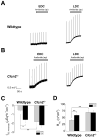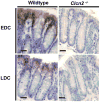Severe defects in absorptive ion transport in distal colons of mice that lack ClC-2 channels
- PMID: 22079595
- PMCID: PMC3267842
- DOI: 10.1053/j.gastro.2011.10.037
Severe defects in absorptive ion transport in distal colons of mice that lack ClC-2 channels
Abstract
Background & aims: The fluid secretion model predicts that intestinal obstruction disorders can be alleviated by promoting epithelial Cl(-) secretion. The adenosine 3',5'-cyclic monophosphate (cAMP)-activated anion channel CFTR mediates Cl(-)-dependent fluid secretion in the intestine. Although the role of the ClC-2 channel has not been determined in the intestine, this voltage-gated Cl(-) channel might compensate for the secretory defects observed in patients with cystic fibrosis and other chronic constipation disorders. We investigated whether mice that lack ClC-2 channels (Clcn2(-/-)) have defects in intestinal ion transport.
Methods: Immunolocalization and immunoblot analyses were used to determine the cellular localization and the amount of ClC-2 expressed in mouse early distal colon (EDC) and late distal colon (LDC). Colon sheets from wild-type and Clcn2(-/-) littermates were mounted in Ussing chambers to determine transepithelial bioelectrical parameters and Na(+), K(+), and Cl(-) fluxes.
Results: Expression of ClC-2 was higher in the basolateral membrane of surface cells in the EDC compared with the LDC, with little expression in crypts. Neither cAMP nor Ca(2+)-induced secretion of Cl(-) was affected in the EDC or LDC of Clcn2(-/-) mice, whereas the amiloride-sensitive short-circuit current was increased approximately 3-fold in Clcn2(-/-) EDC compared with control littermates. Conversely, electroneutral Na(+), K(+), and Cl(-) absorption was dramatically reduced in colons of Clcn2(-/-) mice.
Conclusions: Basolateral ClC-2 channels are required for colonic electroneutral absorption of NaCl and KCl. The increase in the amiloride-sensitive short-circuit current in Clcn2(-/-) mice revealed a compensatory mechanism that is activated in the colons of mice that lack the ClC-2 channel.
Copyright © 2012 AGA Institute. Published by Elsevier Inc. All rights reserved.
Conflict of interest statement
Figures





References
-
- Quinton PM. Physiological basis of cystic fibrosis: a historical perspective. Physiol Rev. 1999;79:S3–S22. - PubMed
-
- Knowles MR, Stutts MJ, Spock A, et al. Abnormal ion permeation through cystic fibrosis respiratory epithelium. Science. 1983;221:1067–70. - PubMed
-
- Kopelman H, Corey M, Gaskin K, et al. Impaired chloride secretion, as well as bicarbonate secretion, underlies the fluid secretory defect in the cystic fibrosis pancreas. Gastroenterology. 1988;95:349–55. - PubMed
-
- Anderson MP, Gregory RJ, Thompson S, et al. Demonstration that CFTR is a chloride channel by alteration of its anion selectivity. Science. 1991;253:202–5. - PubMed
-
- Clarke LL, Grubb BR, Gabriel SE, et al. Defective epithelial chloride transport in a gene-targeted mouse model of cystic fibrosis. Science. 1992;257:1125–8. - PubMed
Publication types
MeSH terms
Substances
Grants and funding
LinkOut - more resources
Full Text Sources
Molecular Biology Databases
Miscellaneous

